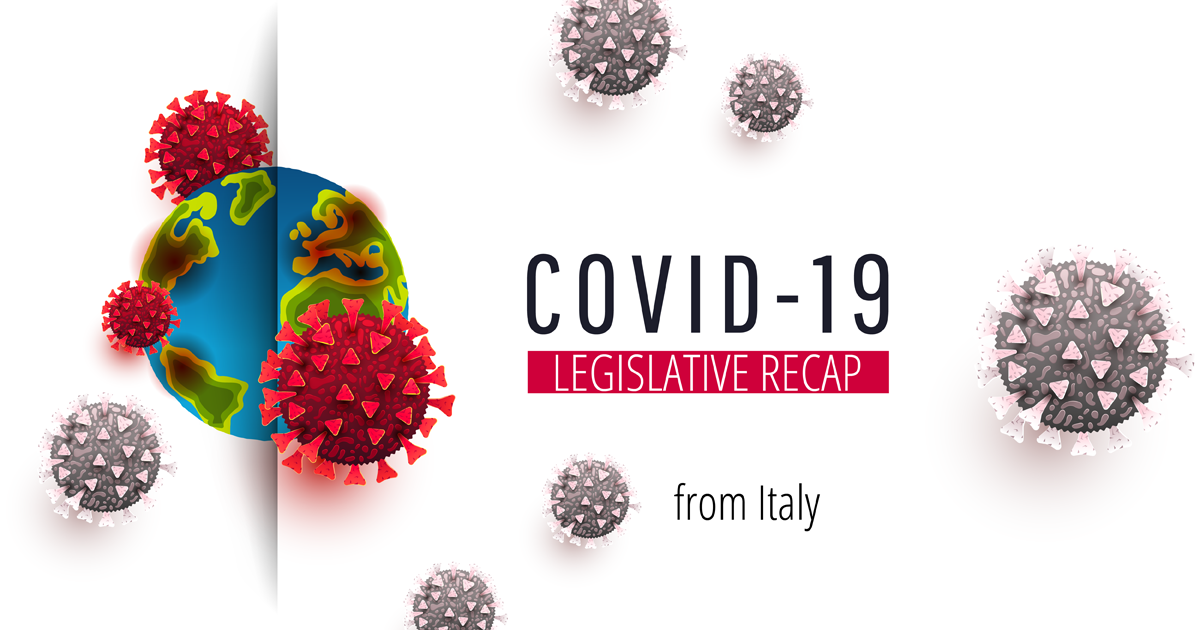COVID-19: Focus on Italy. The seventh legislative recap
An overview of the situation in Italy, with regards to the Covid-19 contagion spread and the Government’s response. You will find:
- A timeline of the major events that marked the contagion spread and the measures taken by the Government
- State of play of the reopening process under s.c. Phase 3
- The impact of the reopening on the contagion spread: the situation is worsening in several Regions as a result of partially open borders
- Restrictions on border crossings: an overview of the regulatory framework
- An overview of the Government’s €55 billion economic recovery package, passed in May
- Next steps in the Government’s economic policy agenda: another economic recovery package expected in mid-August and the debate on whether Italy should apply for an ESM credit line
- Shielding strategic companies from foreign takeover: implementation of the Government’s s.c. Golden Power
- The latest available data on the contagion spread (as of 05 August)
TIMELINE
22 January 2020
Ministry of Health Guidelines to healthcare units: patients to be tested for coronavirus include those showing symptoms of severe acute respiratory infection who have also visited China in the 14 days before the symptoms or have been in contact with someone who has.
31 January
All direct incoming flights from China, Hong Kong, Macau and Taiwan suspended. Still no measure in place to test and place in quarantine those arriving from other countries after visiting China.
8 February (until 22 February)
The Ministry of Health runs an ad on national TV channels where a well-known actor says that “the contagion spread is not at all easy”.
18-20 February
“Patient 1” visited in a hospital in Codogno, south of Milan (Lombardy Region). According to the Guidelines of the Ministry of Health, he is not tested because he had not visited China, and he is sent home on 18 February. Symptoms get worse and he shows up again the next day: this time he is tested and diagnosed with coronavirus, after infecting his relatives, several patients in that hospital as well as health professionals. This marks the beginning of the (recorded) circulation of the virus in Italy.
22 February
The Ministry of Health revises its guidelines to healthcare units: those who show symptoms of a severe acute respiratory infection should also be tested.
24 February
Government establishes two “Red Zones” which are completely locked down:
- 10 towns in Lombardy (including Codogno)
- 1 town in Veneto
Business activities are suspended in that area.
1 March
The rules applying to the “Red Zones” are extended until 8 March.
A “Yellow Zone” is established, including 3 Northern Regions (Lombardy, Veneto, Emilia-Romagna) plus 2 other Provinces in other neighbouring Regions.
Restrictions to social interaction were in place throughout the “Yellow Zone” (including the suspension of sports events, organized public gatherings, school and university attendance, limitations on the opening hours of museums, restaurants, bars, shops, malls etc.) but there was no generalised suspension of business activities.
2 March
The Government adopts legislation providing for an extension of deadlines for tax/bill payments for households and businesses in the “Red Zone”.
4 March
A number of restrictions are imposed on the whole country. School and University attendance is suspended until 15 March.
8 March
The lockdown regime is lifted on the 11 towns of the former “Red Zone”. Lombardy + other 14 Northern Provinces now form an “Orange Zone”, where severe limitations to social interaction, freedom of movement and some business activities apply, but no lockdown is in place: manufacturing sites continue to be operational and transport of goods is not affected.
9 March
The “Orange Zone” regime is extended to the whole country, until 3 April.
11 March
The “Orange Zone” regime is tightened: with a few exemptions, retail merchants are shut down until 25 March. Manufacturing sites are still not impacted.
11 March
Upon the Government’s request, Parliament authorised an increase in the 2020 deficit ceiling by €25bn.
14 March
Amid blue collars’ protests, the Government signs a protocol with Unions and business associations to safeguard workers’ health in manufacturing sites, in an attempt at avoiding a shutdown of factories.
17 March
The Government passes, with the Decree-Law 17 March 2020, n. 18, a €25bn package of measures to provide economic relieve to households and businesses.
22 March
The “Orange Zone” is further tightened through a Prime Minister Decree: the lockdown now applies to manufacturing sites as well, although with several exemptions. All previous measures are extended until 3 April.
24 March
Restrictions on the movement of people are also extended until 3 April, including an obligation for anyone entering Italy to undergo a 15-day quarantine (unless they are entering the country for proven work reasons, in which case they can stay in Italy for no longer than 5 days).
25 March
- The list of manufacturing sectors that are exempted from the lockdown is slightly amended through Decree 25 March 2020 signed by the Minister of Economic Development, Patuanelli.
- The Government sets out a new legal framework (Decree-Law of 25 March 2020 n.19) for any future restriction until 31 July. Regions may adopt additional restrictions but are not allowed to take measures that impact on production facilities.
28 March
Amid concerns about the spread of poverty throughout the country, the Government distributes €400 million to local Administrations (Municipalities) so that they can provide low-income citizens with food stamps.
1 April
The “Orange Zone” regime is extended until 13 April.
3 April
Peak of patients in intensive care units (4,068). This figure started declining on 4 April
4 April
Peak of (non-ICU) hospitalised patients showing Covid-19 related symptoms (29,010). This figure started declining on 5 April
6 April
The Government passes a new package of measures to provide liquidity support to businesses (Decree-Law of 8 April 2020 n.23): bank loans to businesses are assisted with the State’s guarantee, with a view to mobilising up to €200 billion.
Moreover, this package includes measures (specifically, art. 15, 16 and 17) extending the scope of the s.c. Golden Power (e.g. special intervention power aimed at protecting strategically-relevant assets from foreign acquisition, by imposing conditions or even vetoing notified transactions).
10 April
The “Orange Zone” regime is extended until 3 May, with minor exemptions.
14 April
First meeting of the working group (chaired by former CEO of Vodafone Vittorio Colao) which will deliver recommendations to the Government on when to lift the restrictions on individual economic sectors.
19 April
Peak of confirmed active cases (108,257). This figure started declining on 20 April, which means that the total number of patients who recover or die over the last 24 hours is higher than the number of new cases.
20 April
The Regional and Mayoral elections scheduled in May-June 2020 were postponed to September-December.
26 April
A PM Decree sets out the rules applying from 4 May to 17 May (“Phase 2”): factories and businesses in the construction sector are allowed to reopen, conditional upon compliance with workers’ safety protocols.
30 April
A Decree of the Minister of Health lays down the indicators according to which this risk assessment will be conducted during “Phase 2” with a view to detecting any threats and adopt restrictions on a regional or sub-regional basis accordingly.
4 May
“Phase 2” begins, according to the rules set out by the PM Decree of 26 April
13 May
The Cabinet adopts a €55 billion economic recovery package
16 May
The Cabinet adopts the Decree-Law of 16 May 2020 n.33, providing for the legal framework for the gradual resumption of the movement of people and economic activity until the end of the covid-19 emergency (31 July).
17 May
A PM Decree lifts most restrictions on economic activity and restores free movement of people within their own Region starting from 18 May.
3 June
Pursuant the PM Decree of 17 May, free movement of people is restored across regional borders and to/from Schengen area countries
9 June
The working group of experts appointed by the Prime Minister and chaired by former Vodafone CEO Vittorio Colao submits its final report “Italy 2020-2022: Initiatives for recovery” to the Government.
11 June
A PM Decree sets the regulatory framework applying in the following month. Movement of people to/from non-European countries remains restricted at least until 30 June.
13-20 June
The Prime Minister consults with a wide array of economic and social categories, with a view to gathering suggestions for the forthcoming economic recovery plan, basing on which Italy will ask for its share of the “Next Generation EU” funds.
30 June
The Minister of Health signs an Ordinance extending the obligation on any incoming traveller from a non-EU/non-Schengen country to undergo a 14-day quarantine.
9 July
The Minister of Health imposed a ban on the entry into Italy and the travel through Italy of anyone who has stayed in a list of non-EU/non-Schengen countries in the 14 days before his/her travel
14 July
A PM Decree extends all existing restrictions on economic activity and border crossings until 31 July.
16 July
The Government adopts the s.c. Simplification Decree (Decree-Law n.76/2020) laying down measures to streamline bureaucratic procedures across a wide variety of domains to facilitate economic activity.
24 July
The Minister of Health signed a new Ordinance under which incoming travellers who have stayed in Romania or Bulgaria in the 14 days before entering the Italian territory are under an obligation to undergo a 14-day quarantine.
29 July
Parliament authorises the Government to increase the deficit by €25 billion in 2020, thus paving the way towards the adoption of a new economic recovery package.
30 July
The Cabinet extended the Covid-19 emergency until 15 October. All restrictions in place were extended by 10 days, pending the adoption of a new PM Decree.
PHASE 3 OF THE RESPONSE TO THE EPIDEMIC: STATE OF PLAY OF THE REOPENING PROCESS
The Covid-19 emergency was extended until 15 October: until then, the Prime Minister, the Minister of Health and Regional Presidents will retain the power to impose restrictions on economic activity, social life and border crossings.
In here are the main rules disciplining the reopening; these measures were originally meant to apply until 14 July, but were extended and are still in force, pending the adoption of the next PM Decree.
HEALTH RISK ASSESSMENT (20-26 JULY): THE SITUATION IS WORSENING IN SEVERAL REGIONS AS A RESULT OF PARTIALLY OPEN BORDERS
Basing on the data submitted by the Regions and Autonomous Provinces in the week between 20 July and 26 July, for the first time since the weekly risk assessment was started in early May, the Ministry concluded that while the situation is still not critical, there are signals that require particular attention, particularly in light of the increase in the incidence of newly diagnosed cases in nearly all the Regions.
Compared to 4-6 weeks ago, the situation has significantly worsened in the vast majority of Regions, including those in central and southern Italy (+ Sicily and Sardinia) which were basically Covid-free until mid-June.
The rise in newly diagnosed cases in these areas is partially offset by the improvement in Regions like Lombardy and Piedmont, where the situation was still relatively critical during phase 2.
The above-described trend appears to be mainly due to the rise of s.c. “imported cases”, i.e. incoming positive travellers or migrants coming from abroad as a result of the partial resumption of free movement of people on 3 June.
The decrease in average age of patients diagnosed with Covid-19 (now around 40) is due to the relatively high fraction of “imported cases”, as well as to the detection of more asymptomatic patients. The declining average age is also reflected in the very low number of patients requiring hospitalisation, as a result of which there is still no sign that hospitals and ICUs are overloaded despite the increase in newly diagnosed cases.
BORDER CROSSINGS: RULES IN PLACE
Amid concerns that reopening borders might lead to a second wave of contagion, the Minister of Health introduced further restrictions to border crossings by travellers coming from non-EU, non-Schengen countries, and even from EU Member States like Romania and Bulgaria.
The rules in place at the moment are the following:
- Unrestricted movement of people is allowed to and from EU Member States (with the exception of Romania and Bulgaria), other Schengen area countries, plus the UK, Andorra, the Principality of Monaco, the Republic of San Marino and the Vatican City
- Travellers from a “white list” of non-EU, non-Schengen countries plus Romania and Bulgaria may cross the Italian border for whatever purpose one the condition that they undergo a 14-day quarantine
- Travelling to and from any other third country is forbidden, unless for proven reasons of work, study, extreme urgency and health. In this case as well, travellers shall undergo a 14-day quarantine as soon as they cross the Italian border, with minor exceptions
- A total travel ban applies to anyone who has stayed in a “black list” of at-risk countries in the 14 days before his/her travel. Flights to and from these countries are suspended.
You can find more detail on the current rules here.
€55 BILLION ECONOMIC RECOVERY PACKAGE to tackle the economic downturn
The package was adopted by the Cabinet on 13 May. These are the main provisions:
- Extended income support schemes (€25.6 billion overall)
- Aid to businesses (€16 billion)
- Temporary tax cuts (€4 billion) + suppression of the increase in VAT rates and excise duties already legislated for 2021 onwards
- Additional funding for the NHS and the civil protection department (€3.25 billion)
GOVERNMENT’S ECONOMIC RECOVERY AGENDA: NEXT STEPS AND POLITICAL DEBATE ON THE EUROPEAN STABILITY FUND
On 29 July, Parliament authorised the Government to further increase the deficit by €25 billion in 2020, thus further deviating from the path towards the medium-term budgetary objective (MTO). The increased deficit will bring the deficit-to-GDP ratio up to 11.9% this year and the debt-to-GDP ratio up to 157.6%, according to the Government’s latest projections.
The Cabinet is now expected to adopt a new economic recovery package within mid-August.
Going forward:
- In September, the Italian Government will submit a national recovery plan to the European Commission, for the purpose of applying for the “Next Generation EU” funds
- Within 27 September, the Cabinet will then adopt its updated multiannual financial framework, with its macroeconomic estimates for 2020, 2021 and 2022
- Within 20 October, the Cabinet will adopt its draft 2021 Budget, which is scheduled to be passed by Parliament within 31 December.
Since the “Next Generation EU” funds will only be available at a later stage (most likely next year), the Government might want to apply for a European Stability Mechanism (ESM) credit line under the new pandemic crisis support scheme, i.e. with lightened conditionalities: funds available under this scheme would be up to 36 billion (2% of the national GDP), borrowed at an interest close to zero, which Italy would be allowed to spend only for the purpose of financing direct and indirect healthcare, cure and prevention related costs due to the covid-19 crisis.
However, the Five Star Movement (largest party in the majority supporting the Government) is officially opposed to resorting to an ESM loan, as are the Eurosceptic opposition parties on the right (Lega and Fratelli d’Italia), while the moderate majority parties (Democratic Party and Italia Viva) and the main business associations are putting pressure on the Prime Minister to use the ESM funds.
This issue has a potential for threatening the Government’s stability, as the debate on the ESM could bring about a split in the Five Star Movement.
SHIELDING STRATEGIC COMPANIES FROM FOREIGN TAKEOVER: IMPLEMENTATION OF THE GOVERNMENT’S s.c. GOLDEN POWER
The Decree-Law n.23/2020 expanded the scope of the s.c. Golden Power, an investment screening mechanism established in 2012 whereby any transaction affecting the corporate governance and shareholding structure of a strategic company, whether it be public or private, listed or non-listed, shall be notified to the Government, which in turn may set additional requirements or block the transaction altogether.
On 28 May, the Cabinet agreed upon the draft text of a Prime Minister’s Decree implementing Decree-Law 23/2020. In particular, the draft PM Decree identified a detailed list of goods and transactions on which the Government may resort to its special intervention power aimed at protecting strategically-relevant assets from foreign acquisition.
CONTAGION SPREAD: LATEST AVAILABLE DATA (05 August)
These are the official data which are updated on a daily basis by the Italian Government:
Tests: ~7 million
Overall number of people who were infected with Covid-19: 248,803
Deaths: 35,181
People fully recovered: 200,976
Confirmed cases as of 05 August: 12,646 [peak: 108,257 on 19 April]
Of the confirmed cases:
- Hospitalised patients (showing symptoms): 764 [peak: 29,010 on 4 April]
- Under intensive care: 41 [peak: 4,068 on 3 April]
- In quarantine at home: 11,841






SocialTelos